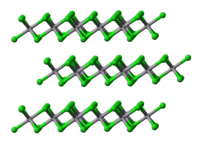Vanadium(III) chloride
 Anhydrous
| |

| |
| Names | |
|---|---|
| IUPAC names
Vanadium(III) chloride
Vanadium trichloride | |
| Identifiers | |
3D model (
JSmol ) |
|
| ChemSpider | |
ECHA InfoCard
|
100.028.859 |
| EC Number |
|
PubChem CID
|
|
RTECS number
|
|
| UN number | 2475 |
CompTox Dashboard (EPA)
|
|
| |
| |
| Properties | |
| VCl3 | |
| Molar mass | 157.30 g/mol |
| Appearance | violet crystals (anhydrous) green crystals (hexahydrate)[1] |
| Density | 2.8 g/cm3 (anhydrous) 1.84 g/cm3 (hexahydrate) |
| Melting point | 350 °C (662 °F; 623 K)[2] (decomposes, anhydrous) |
| soluble | |
| +3030.0·10−6 cm3/mol | |
| Structure | |
| R3, No. 148[3] | |
a = 6.012 Å, b = 6.012 Å, c = 17.34 Å α = 90°, β = 90°, γ = 120°[3] (anhydrous)
| |
| Thermochemistry[4] | |
Heat capacity (C)
|
93.2 J mol−1 K−1 |
Std molar
entropy (S⦵298) |
131.0 J mol−1 K−1 |
Std enthalpy of (ΔfH⦵298)formation |
-580.7 kJ/mol |
Gibbs free energy (ΔfG⦵)
|
-511.2 kJ/mol |
| Hazards | |
| GHS labelling:[5] | |
 
| |
| Danger | |
| H302, H314 | |
| P260, P264, P270, P280, P301+P312+P330, P301+P330+P331, P303+P361+P353, P304+P340+P310, P305+P351+P338+P310, P363, P405, P501 | |
| NFPA 704 (fire diamond) | |
| Flash point | Non-flammable |
| Safety data sheet (SDS) | Vanadium(III) Chloride |
| Related compounds | |
Other anions
|
Vanadium(III) fluoride Vanadium(III) bromide Vanadium(III) iodide |
Other cations
|
Titanium(III) chloride Chromium(III) chloride Niobium(III) chloride Tantalum(III) chloride |
Related compounds
|
Vanadium(IV) chloride
|
Except where otherwise noted, data are given for materials in their standard state (at 25 °C [77 °F], 100 kPa).
| |
Vanadium(III) chloride describes the
Structure and electronic configuration
VCl3 has the common layered
Solid hexahydrate, [VCl2(H2O)4]Cl·2H2O, has a monoclinic crystal structure and consists of slightly distorted octahedral trans-[VCl2(H2O)4]+ centers as well as chloride and two molecules of water of crystallization.[10][11] The hexahydrate phase loses two water of crystallization to form the tetrahydrate if heated to 90 °C in a stream of hydrogen chloride gas.[1]
Uses
Solutions of vanadium(III) chloride in
Preparation
VCl3 is prepared by heating VCl4 at 160–170 °C under a flowing stream of inert gas, which sweeps out the Cl2. The bright red liquid converts to a purple solid.[15]
The vanadium oxides can also be used to produce vanadium(III) chloride. For example, vanadium(III) oxide reacts with thionyl chloride at 200 °C:[15]
- V2O3 + 3 SOCl2 → 2 VCl3 + 3 SO2
The reaction of vanadium(V) oxide and disulfur dichloride also produces vanadium(III) chloride with the release of sulfur dioxide and sulfur.[15]
The hexahydrate can be prepared by evaporation of acidic aqueous solutions of the trichloride.[1]
Reactions
Heating of VCl3 decomposes with volatilization of VCl4, leaving VCl2 above 350 °C.[2][16] Upon heating under H2 at 675 °C (but less than 700 °C), VCl3 reduces to greenish VCl2.
- 2 VCl3 + H2 → 2 VCl2 + 2 HCl
Comproportionation of vanadium trichloride and vanadium(V) oxides gives vanadium oxydichloride:[17]
- V2O5 + VOCl3 + 3 VCl3 → 6 VOCl2
The heating of the hexahydrate does not give the anhydrous form, instead undergoes partial hydrolysis and forms vanadium oxydichloride at 160 °C. In an inert atmosphere, it forms a trihydrate at 130 °C and at higher temperatures, it forms vanadium oxychloride.[18]
Vanadium trichloride catalyses the pinacol coupling reaction of benzaldehyde (PhCHO) to 1,2-diphenyl-1,2-ethanediol by various reducing metals such as zinc:[19]
- Zn + 2 H2O + 2 PhCHO → (PhCH(OH))2 + Zn(OH)2
Complexes
VCl3 forms colorful adducts and derivatives with a broad scale of ligands. VCl3 dissolves in water to give the


With tetrahydrofuran, VCl3 forms the red/pink complex VCl3(THF)3.[22] Vanadium(III) chloride reacts with acetonitrile to give the green adduct VCl3(MeCN)3. When treated with KCN, VCl3 converts to [V(CN)7]4− (early metals commonly adopt coordination numbers greater than 6 with compact ligands). Complementarily, larger metals can form complexes with rather bulky ligands. This aspect is illustrated by the isolation of VCl3(NMe3)2, containing two bulky NMe3 ligands. Vanadium(III) chloride is able to form complexes with other adducts, such as pyridine or triphenylphosphine oxide.[20]
Organometallic derivatives
Vanadium(III) chloride as its thf complex is a precursor toV(mesityl)3.[23]
- VCl3(THF)3 + 3 LiC6H2-2,4,6-Me3 → V(C6H2-2,4,6-Me3)3(THF) + 3 LiCl
References
- ^ .
- ^ .
- ^ .
- ISBN 978-1-138-56163-2.
- ^ "Vanadium(III) Chloride SDS". American Elements. Retrieved 2018-08-17.
- ISBN 0-12-352651-5.
- ^ S2CID 255942777.
- ISBN 0-7506-3365-4.
- .
- ^ .
- .
- ISBN 978-3-527-30385-4.
- .
- .
- ^ ISBN 978-3-432-87823-2.
- ISBN 978-0-470-13235-7.
- ^ G. Brauer (1963). "Vanadium Oxydichloride". In G. Brauer (ed.). Handbook of Preparative Inorganic Chemistry, 2nd Ed. NY: Academic Press. p. 1263.
- ISBN 978-0-471-16625-2.
- PMID 16209617.
- ^ .
- .
- ISBN 978-0-471-86520-9.
- .




